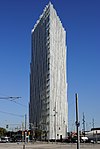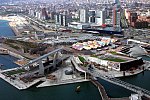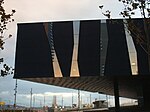Besòs Mar station
Barcelona Metro line 4 stationsBarcelona Metro stubsCatalan railway station stubsTransport in Sant Martí (district)

Besòs Mar is a station in the Barcelona Metro, in La Mina, an area of the Sant Martí district of Barcelona. It's served by L4. It was opened in 1982 as La Mina, but it was controversially renamed with the construction of the Barcelona Fòrum and revamping of the adjacent area into Besòs Mar, alluding to the proximity to the Mediterranean Sea and to the Besòs river in order to diminish the reference to the neighbourhood's name which had become infamous. It's located underneath carrer d'Alfons el Magnànim between carrer de Lluís Borrassà and carrer de Ferrer Bassa.
Excerpt from the Wikipedia article Besòs Mar station (License: CC BY-SA 3.0, Authors, Images).Besòs Mar station
Carrer d'Alfons el Magnànim, Barcelona
Geographical coordinates (GPS) Address External links Nearby Places Show on map
Geographical coordinates (GPS)
| Latitude | Longitude |
|---|---|
| N 41.414722222222 ° | E 2.2166666666667 ° |
Address
Besòs Mar
Carrer d'Alfons el Magnànim
08001 Barcelona (Sant Martí)
Catalonia, Spain
Open on Google Maps








